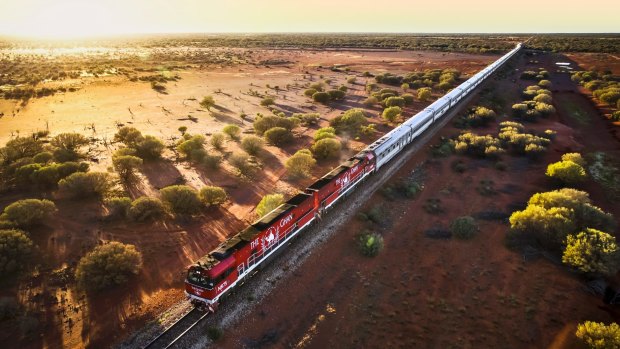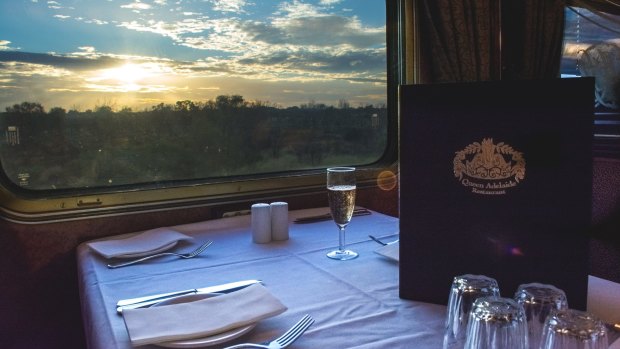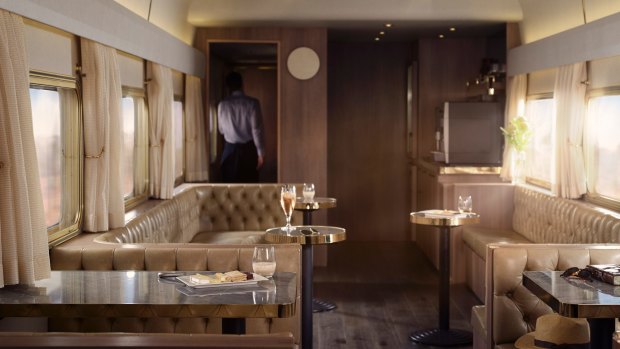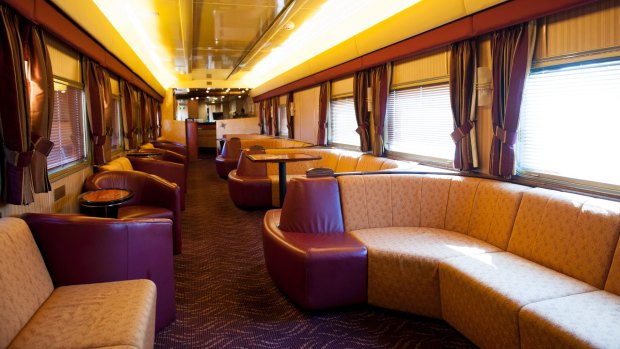This was published 5 years ago
Travelling The Ghan: Australia's greatest train journey
By Terry Durack and Jill Dupleix
We were your typical Australian travellers. Been to Stonehenge, the Grand Canyon, and the Sahara. Eaten Peking duck in Beijing, drunk manhattans in New York. Taken the Orient Express to Venice, the Eurostar to Paris, and knew the London Tube backwards.
But Australia? We had never ventured into the centre of our own country; never been to Uluru or Coober Pedy, and never even considered travelling the 2,979 kilometres of railway track that splits Australia right down the middle, from Darwin to Adelaide. And then, one Sunday evening in November, 2017, we watched The Ghan, Australia's Greatest Train Journey.
AS SEEN ON TV

The Ghan – not dividing the country but bringing it together.
SBS Television's three hour-long "Slow TV" special set a new viewing record that night, watched by 612,000 people across the country. There was no actual plot and little dialogue; just the train itself, moving slowly and almost dreamily through the Australian outback, the vision captured by 12 cameras.
One of us was utterly mesmerised, and the other was bored silly. Our marriage is based on a number of kind and reasonable rules, however, and if one person wants to do something badly enough, the other has to go along with it.
It seems we weren't the only ones. Great Southern Rail reported 2 million hits on their website, followed by a 74 per cent increase in bookings. The number of marital debates in the middle remains unrecorded.

In the dining car, expect to find regionally sourced produce.
In reality, of course, the trip takes more than three hours. The Ghan Expedition is a three-day/four-night, all-inclusive journey from Darwin to Adelaide, departing weekly from March to October, with stops in Alice Springs, Nitmiluk (Katherine) and Coober Pedy. That's a lot of time to spend on a train, thought one of us.
ALL ABOARD
At the Hilton Darwin, cheery young staff in Akubra hats herd their passengers onto the transfer bus with the bright-eyed determination of skilled cattle dogs. Fellow travellers are mainly Australians and New Zealanders in their 50s and 60s, with the odd German and American, and one adorable seeing-eye dog named Chris, on his last trip before retiring at the age of 10.

Oozing charm: The Ghan.
The Ghan is a far cry from those sleek, futuristic metal pythons that slither into European and Japanese stations with little more than a whisper. The two locomotives with their 4400hp diesel/electric engines (the second only for back-up) are big, bold, blood-red, blunt-faced work-horses, strong enough to pull nearly a kilometre of carriages, 327 passengers and 55 on-board crew, with an all-up weight of 1654 tonnes.
But first, a little history. The Ghan was named for the pioneering cameleers (and camels) from Afghanistan and elsewhere who arrived in Adelaide in the 1860s, charged with helping the exploration and mapping of central Australia. They succeeded so well that the new settlements soon required rail to facilitate communication and supply systems. The inaugural steam-hauled train took off from Adelaide for Alice Springs on August 4, 1929, and the track was finally extended to Darwin in 2004.
THE JOYS OF SLOW TRAVEL

Sit back and enjoy the ride from Darwin to Adelaide.
Waking up in the morning and opening the window blind is like switching on the TV show yet again. Earth that changes from rust-red to ash black to quartz pink to an archaic bleached and oxidised sandstone. Stubby-legged ponies and cattle, inevitably the same colour as the soil. Long, straggly fingers of water beneath long bridges, spreading out like the veins on the back of a hand. Cathedral towers of termite mounds, cleverly built on a north/south axis to avoid the worst of the sun's rays.
And the birds – wedge-tailed eagles soaring; galahs canoodling on wires; buzzards, goshawks, kites. And the trees – silvery ghost gums and older eucalypts with trunks the colour of rusting carrots; pandanus connecting itself to the earth with every hanging vine. And the clouds – huge white fluffbuckets, streaky shreds of fairy floss, bouncy cushions viciously sheared flat at the base. And every now and then, a glimpse of the train ahead, sinuously leaning into a curve, pulling us forward.
HOME SWEET HOME
Our Gold Class cabin is cute and compact (it's the anti-Tardis, smaller on the inside) but cleverly designed to be a three-seater lounge by day, complete with one-person-at-a-time en suite. Military-strength strategy is required to devise storage for specs, books, shoes, toiletries. There is a tiny table for your cup of tea, a small cupboard for hanging clothes and a little shelf for – everything else.
While at dinner, the cabin is miraculously converted into comfortable bunk beds, the top one reached by a sturdy ladder (and best allocated to the one least likely to go to the loo in the middle of the night). Heads barely hit the pillow before the rhythm and movement of the carriage rocks us to sleep.
WHAT ABOUT THE FOOD?
Train food is often institutionalised, but there's real effort here to source produce regionally, and deliver freshness and variety. The 48-seat Queen Adelaide restaurant car is a charmer, with the added serendipity of sitting with new and different fellow guests at cosy tables of four with full table service. On-board chefs give us a taste of the Territory with Panang-style buffalo curry or chicken salad with desert lime and native pepper dressing. Breakfasts are brilliant, with tea and toast on tap; and honourable mentions should go to the ice-creams and espresso coffee.
After a pre-dinner Tanqueray gin and tonic or Peroni in the comfy, sociable Outback Explorer Lounge, it's an unexpected pleasure to explore a short but solid wine list of quality South Australian wines. Clear favourites are a vibrant zesty Coriole chenin clanc and a juicy, generous Tim Smith Mataro grenache shiraz. Perhaps that's why we sleep so well, come to think of it.
OFF-TRAIN AND ON COUNTRY
By 3pm on the first day out of Darwin, we are on a flat-bottomed boat cruising down Nitmiluk (Katherine) Gorge, jewel of the 292,000 hectare Nitmiluk National Park, traditional land of the Jawoyn people. In the deep shadows of skyscraper-tall sandstone cliff faces carved out by the river over 23 million years, we clamber over rocks to reach the next gorge; spot a freshwater crocodile and gaze up in awe at Jedda's Rock, star of the 1955 Claude Chauvel film, Jedda.
The next day in Alice Springs ends with an outback barbecue dinner at the immaculately restored Alice Springs Telegraph station, complete with camel rides, blacksmith exhibitions and a country music concert. The final day takes us to the extraordinary Mad Max film set that is Coober Pedy, where we learn how to mine for opals, and lunch underground on Greek dips and pita bread, calamari and feta salad. It's a long time between cars out here in Dorothea McKellar's ''opal-hearted country". Just as the dirt track out of town is about to join a slightly larger dirt track, a single campervan zooms past, crimson dust hanging like a shroud behind it. "Must be peak hour," deadpans our driver.
HELLO, ULURU
One of the few optional extras (everything else, from dry martinis to gala sunset dinners, is inclusive) is a fixed-wing scenic flight from Alice Springs to Uluru, for a close-up and personal with one of the wonders of the world.
Seven of us pile into a twin-engine Cessna Titan and take off from Alice Springs Airport with all the associated rattling and shaking that's familiar to old hands but terrifies newbies. Northern Territory Air Services chief pilot, Jim Wallace, as weather-beaten as Kata Tjuta and as dry as the Simpson desert, calls the land below us his "backyard".
Then suddenly there it is, the rock itself, a hulking 348 metres high. Majestic, its draped folds almost theatrical, it's like the top half of an ancient elephant, caught in quicksand, or the hull of a capsized ocean liner.
A mini-bus ferries us to a clever vantage point, where the rock seemingly floats between ochre and electric Pantone blue. It's as if someone has put the entire country on a high-contrast lo-fi Instagram filter. Staff unpack a Tupperware picnic lunch and we roll our own roast chicken and salad wraps. It's hot. We are plied with water, but a beer would have gone down well.
Then we move to the rock to walk around its eastern side, discovering the Mutitjula waterhole and rock art in sheltered caves, listening to age-old stories of Wanampi, the ancestral water snake. We learn to say "hello" in the local Pitjintjara language – "palya". There are moments when all you can hear are the cry of birds, the buzz of an insect, the trickle of water. It's how this place has sounded for millennia, and it bonds this special, sacred site somewhere deep inside.
Driving back past the line of men, women and small children climbing the steep slopes is surprisingly distressing. It feels like trespass. The local Ananga culture is founded on Tjukurpa, the traditional laws of nature, and visitors are asked to respect Tjukurpa by not climbing Uluru. Roll on October 2019, when climbing will be banned.
2979 KILOMETRES LATER
As our multi-tasking restaurant manager, Sheree Richardson, says, "The Ghan isn't a journey just to get from A to B. It's all about the experience in between." For three days, it has been all about the rhythm of the train, the endlessness of the sky, and the hypnotic relentlessness of the metal track before us, beneath us and behind us. On the final morning, as we tuck into eggs benedict with smoked barramundi and a potato galette, so-called civilisation approaches as we glide by Port Augusta and the Flinders Ranges, through ever-more-fenced farmland, and into Adelaide.
Back in the city, the lush green lawns suddenly look artificial, as if computer-generated. We have a new appreciation for ochre-stained white sneakers, for mulga and spinifex instead of rose bushes, for the shock of a cold beer on a hot throat, for the dry wit of people who live thousands of miles from the sea. And for the Ghan, as it draws a line – an elongated parabolic curve – from the top to the bottom of Australia, not dividing the country but bringing it together.
TRIP NOTES
MORE
FLY
Qantas, Jetstar and Virgin Australia have regular flights to Darwin.
TOUR
The Ghan Expedition 2019 season operated by Journey Beyond runs from March to October. All-inclusive fares include off-train excursions, transfers, all dining and Australian wines, beers, base spirits, non-alcoholic beverages, teas and coffees (and biscuits!). Prices for Gold Twin cabins start at $2949, Gold Single from $2779 and Platinum Service (larger cabins and double beds) from $5799. The 2019/20 dates are now open for sale. See greatsouthernrail.com.au
Terry Durack and Jill Dupleix travelled as guests of Journey Beyond/Great Southern Rail.
HOW TO PLAN THE GHAN
SPOIL YOURSELF
If money is no object, go Platinum, for the luxury of a larger cabin that converts to a comfortable double bed and an exclusive Platinum Club for Bollinger-sipping as the sun sets. Book early, it sells out fast.
TAKE YOUR TIME
Add a couple of days to the trip at either end, to eat mud crab in Darwin and explore the idyllic winery regions close to Adelaide.
DRESS WELL
Take something warm – even in summer, nights can be chilly, and leave the big cases at home or check them in and board with carry-ons.
KEEP YOUR COMPANY
Travel with one you love, not someone who will annoy you in tight confines.
WATCH THE CLOCK
Don't be late to join off-train excursions – your carriage may be a good 10 minutes' walk from the pick-up point.
See also: The 10 things you need to know about train travel in Europe
Sign up for the Traveller Deals newsletter
Get exclusive travel deals delivered straight to your inbox. Sign up now.